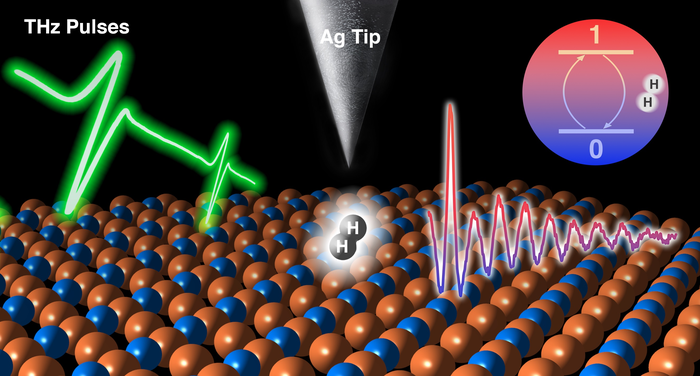Reviewed by Alex SmithApr 25 2022
Physicists from the University of California Irvine have demonstrated the use of a hydrogen molecule as a quantum sensor in a scanning tunneling microscope paired with a terahertz laser, a technology that allows for unprecedented time and spatial resolutions in measuring chemical characteristics of materials.
 In the ultrahigh vacuum of a scanning tunneling microscope, a hydrogen molecule is held between the silver tip and sample. Femtosecond bursts of a terahertz laser excite the molecule, turning it into a quantum sensor. Image Credit: Wilson Ho Lab, University of California, Irvine.
In the ultrahigh vacuum of a scanning tunneling microscope, a hydrogen molecule is held between the silver tip and sample. Femtosecond bursts of a terahertz laser excite the molecule, turning it into a quantum sensor. Image Credit: Wilson Ho Lab, University of California, Irvine.
This novel method may also be used to analyze two-dimensional materials, which could be useful in advanced energy systems, electronics and quantum computers.
The researchers from UCI’s Departments of Physics and Astronomy and Chemistry describe how scientists positioned two bonded hydrogen atoms between both the silver tip of the STM and a sample made up of a flat copper surface arranged with tiny islands of copper nitride. The research was published in the journal Science.
The scientists were able to stimulate the hydrogen molecule and identify changes in its quantum states at cryogenic temperatures and in the extremely high vacuum environment of the device using laser pulses lasting trillionths of a second, resulting in atomic-scale and time-lapsed images of the sample.
This project represents an advance in both the measurement technique and the scientific question the approach allowed us to explore. A quantum microscope that relies on probing the coherent superposition of states in a two-level system is much more sensitive than existing instruments that are not based on this quantum physics principle.
Wilson Ho, Study Co-Author and Donald Bren Professor, Physics & Astronomy and Chemistry, University of California Irvine
As its orientation fluctuates between two locations, up and down, and somewhat horizontally slanted, the hydrogen molecule, according to Ho, is an example of a two-level system. The scientists can encourage the system to cycle from a ground state to an excited state, leading to a superposition of the two states, using a laser pulse.
The cyclic oscillations are extremely short, lasting only a few tens of picoseconds, but scientists were able to detect how the hydrogen molecule interacted with its surroundings by measuring the “decoherence time” and the cyclic periods.
The hydrogen molecule became part of the quantum microscope in the sense that wherever the microscope scanned, the hydrogen was there in between the tip and the sample. It makes for an extremely sensitive probe, allowing us to see variations down to 0.1 angstroms. At this resolution, we could see how the charge distributions change on the sample.
Wilson Ho, Study Co-Author and Donald Bren Professor, Physics & Astronomy and Chemistry, University of California Irvine
The distance between the STM tip and the sample is around six angstroms or 0.6 nanometers, which is nearly impossibly tiny.
Ho and their research colleagues built an STM that can detect minute electrical currents in this area and give spectroscopic data that prove the existence of the hydrogen molecule and specimen components. According to Ho, this is the first time chemical precise spectroscopy depending on terahertz-induced rectification current across a single molecule has been shown.
According to Ho, the ability to analyze materials at this level of detail using hydrogen’s quantum coherence can be very useful in the research and engineering of catalysts, because their functioning is typically dependent on surface defects in the size of single atoms.
As long as hydrogen can be adsorbed onto a material, in principle, you can use hydrogen as a sensor to characterize the material itself through observations of their electrostatic field distribution.
Likun Wang, Study Lead Author, Graduate Student in Physics & Astronomy, University of California Irvine
Yunpeng Xia, a UCI graduate student in physics and astronomy, worked alongside Ho and Wang on this experiment, which was funded by the US Department of Energy’s Office of Basic Energy Sciences.
Journal Reference:
Wang, L., et al. (2022) Atomic-scale quantum sensing based on the ultrafast coherence of an H2 molecule in an STM cavity. Science. doi.org/10.1126/science.abn9220.